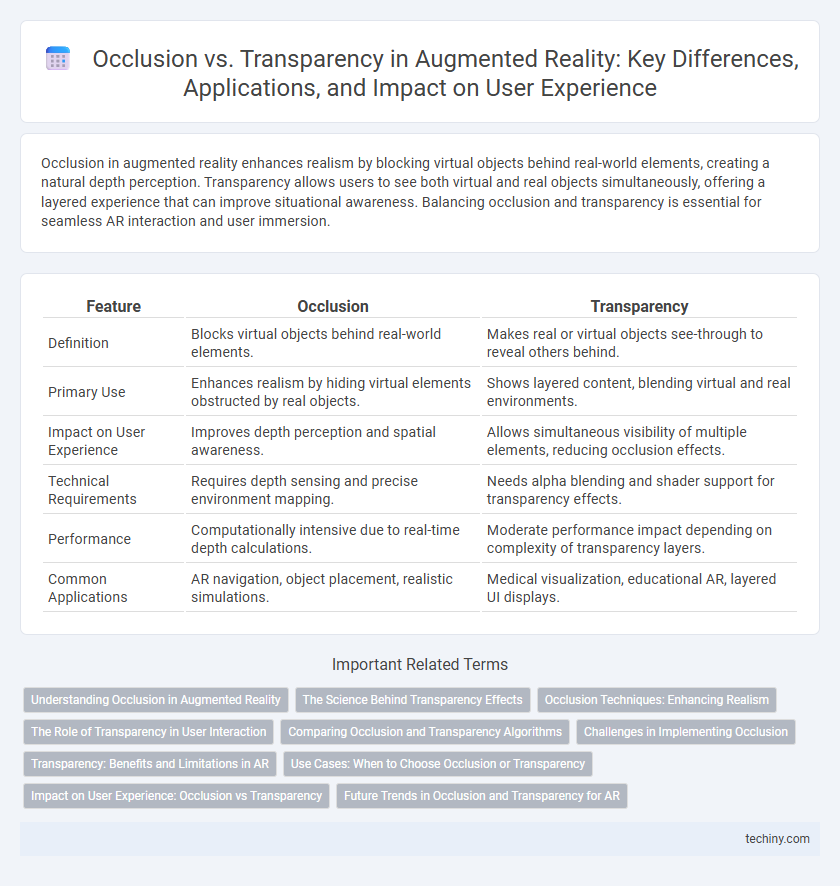Occlusion in augmented reality enhances realism by blocking virtual objects behind real-world elements, creating a natural depth perception. Transparency allows users to see both virtual and real objects simultaneously, offering a layered experience that can improve situational awareness. Balancing occlusion and transparency is essential for seamless AR interaction and user immersion.
Table of Comparison
| Feature | Occlusion | Transparency |
|---|---|---|
| Definition | Blocks virtual objects behind real-world elements. | Makes real or virtual objects see-through to reveal others behind. |
| Primary Use | Enhances realism by hiding virtual elements obstructed by real objects. | Shows layered content, blending virtual and real environments. |
| Impact on User Experience | Improves depth perception and spatial awareness. | Allows simultaneous visibility of multiple elements, reducing occlusion effects. |
| Technical Requirements | Requires depth sensing and precise environment mapping. | Needs alpha blending and shader support for transparency effects. |
| Performance | Computationally intensive due to real-time depth calculations. | Moderate performance impact depending on complexity of transparency layers. |
| Common Applications | AR navigation, object placement, realistic simulations. | Medical visualization, educational AR, layered UI displays. |
Understanding Occlusion in Augmented Reality
Understanding occlusion in augmented reality is crucial for creating immersive experiences by accurately rendering virtual objects behind real-world elements. Proper occlusion enhances spatial awareness, ensuring virtual content appears naturally integrated and respects physical environmental boundaries. Techniques such as depth sensing and 3D mapping enable AR systems to distinguish and accurately overlap virtual objects with real-world structures.
The Science Behind Transparency Effects
Transparency effects in augmented reality rely on advanced light scattering and refraction algorithms to simulate how light passes through and interacts with semi-transparent virtual objects. These effects use depth sensors and ray-tracing techniques to accurately blend virtual elements with real-world backgrounds, enhancing realism by preserving spatial cues. By mimicking optical phenomena such as partial light absorption and reflection, transparency provides users with an intuitive understanding of object layering within AR environments.
Occlusion Techniques: Enhancing Realism
Occlusion techniques in augmented reality enhance realism by accurately blocking virtual objects behind real-world elements, creating a seamless integration of digital content with physical surroundings. Methods such as depth sensing, segmentation, and spatial mapping enable precise detection of surface geometries and object boundaries, improving occlusion accuracy. Advanced algorithms leveraging AI and machine learning further refine occlusion by dynamically adapting to complex environments and lighting conditions.
The Role of Transparency in User Interaction
Transparency in augmented reality enhances user interaction by allowing virtual objects to be seen alongside real-world elements, providing contextual awareness and minimizing visual obstruction. It supports intuitive navigation and interaction by enabling users to perceive depth and spatial relationships without fully blocking the physical environment. Effective transparency management improves task performance and user comfort by balancing virtual content visibility with real-world environmental cues.
Comparing Occlusion and Transparency Algorithms
Occlusion algorithms in augmented reality enhance realism by accurately blocking virtual objects behind real-world surfaces using depth sensing and spatial mapping techniques. Transparency algorithms, on the other hand, adjust the opacity of virtual elements to allow simultaneous visibility of both virtual and real objects, often utilizing alpha blending and shader-based methods. Comparing these approaches reveals occlusion's strength in depth accuracy and immersion, while transparency offers flexibility in user interaction and layering effects within AR environments.
Challenges in Implementing Occlusion
Implementing occlusion in augmented reality presents significant challenges due to the need for accurate depth sensing and real-time environmental mapping to correctly overlay virtual objects behind real-world elements. Occlusion algorithms must process complex spatial data at high speeds to maintain immersion without latency or visual artifacts. Limited hardware capabilities and inconsistent lighting conditions further complicate reliable occlusion rendering in dynamic AR environments.
Transparency: Benefits and Limitations in AR
Transparency in augmented reality enables users to see digital content overlaid on real-world environments without obstructing the background, enhancing situational awareness and user experience. This feature allows for seamless integration of virtual objects, providing contextual information without fully blocking real-world views, which is crucial in navigation and maintenance applications. However, limitations include challenges in rendering transparent objects accurately under varying lighting conditions and potential difficulties in distinguishing virtual content from complex real-world scenes, impacting overall clarity and user perception.
Use Cases: When to Choose Occlusion or Transparency
Occlusion in augmented reality is ideal for applications requiring realistic interactions, such as medical training or industrial design, where virtual objects must appear solid and block real-world elements to enhance depth perception. Transparency is better suited for use cases like architectural visualization or maintenance guidance, where users need to see both virtual overlays and underlying real-world components simultaneously for contextual understanding. Choosing between occlusion and transparency depends on whether spatial immersion or information layering takes priority in the AR experience.
Impact on User Experience: Occlusion vs Transparency
Occlusion in augmented reality enhances user experience by creating a more realistic interaction where virtual objects are hidden behind real-world elements, boosting spatial awareness and immersion. Transparency allows users to see both real and virtual objects simultaneously, facilitating information layering but potentially reducing depth perception and realism. The choice between occlusion and transparency directly affects user engagement, with occlusion providing clarity in complex environments while transparency supports multitasking and data visualization.
Future Trends in Occlusion and Transparency for AR
Future trends in occlusion and transparency for augmented reality emphasize advanced depth sensing and machine learning algorithms to achieve more precise and dynamic object interactions. Improvements in real-time environmental mapping enable seamless blending of virtual and physical worlds, enhancing user immersion through accurate occlusion handling. Emerging hardware such as LiDAR sensors and neural processing units will further drive innovation, allowing AR devices to render transparent and occluded objects with greater realism and responsiveness.
Occlusion vs Transparency Infographic

 techiny.com
techiny.com